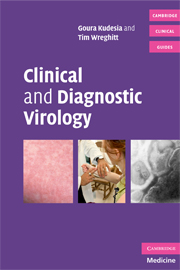Book contents
- Frontmatter
- Contents
- List of plates
- Preface
- Acknowledgements
- SECTION 1 INDIVIDUAL VIRUSES
- SECTION 2 OTHER RELATED AGENTS
- SECTION 3 CLINICAL SYNDROMES
- 32 Central nervous system viral infections
- 33 Viral eye infections
- 34 The common cold
- 35 Respiratory virus infections
- 36 Atypical pneumonia
- 37 Gastroenteritis viruses
- 38 Viral hepatitis
- Chapter 39 Genital tract and sexually transmitted infections (STIs)
- 40 Glandular fever-type illness
- 41 Viral rashes and skin infections
- 42 Infections in pregnancy, congenital and neonatal infections
- 43 Virus infections in immunocompromised patients
- 44 Viral malignancies
- 45 Travel-related infections
- SECTION 4 DIAGNOSTIC TECHNIQUES
- SECTION 5 PATIENT MANAGEMENT
- Index
- Plate section
43 - Virus infections in immunocompromised patients
Published online by Cambridge University Press: 07 December 2009
- Frontmatter
- Contents
- List of plates
- Preface
- Acknowledgements
- SECTION 1 INDIVIDUAL VIRUSES
- SECTION 2 OTHER RELATED AGENTS
- SECTION 3 CLINICAL SYNDROMES
- 32 Central nervous system viral infections
- 33 Viral eye infections
- 34 The common cold
- 35 Respiratory virus infections
- 36 Atypical pneumonia
- 37 Gastroenteritis viruses
- 38 Viral hepatitis
- Chapter 39 Genital tract and sexually transmitted infections (STIs)
- 40 Glandular fever-type illness
- 41 Viral rashes and skin infections
- 42 Infections in pregnancy, congenital and neonatal infections
- 43 Virus infections in immunocompromised patients
- 44 Viral malignancies
- 45 Travel-related infections
- SECTION 4 DIAGNOSTIC TECHNIQUES
- SECTION 5 PATIENT MANAGEMENT
- Index
- Plate section
Summary
There are several categories of immunocompromised patients. Different viruses cause different clinical symptoms in these patients as shown below. HIV positive/AIDS patients often have different symptoms from transplant recipients and need different treatment and prophylactic strategies.
Organ transplant recipients
See Table 43.1.
Cytomegalovirus (CMV)
Cytomegalovirus is the most important virus infection in transplant recipients. Infection acquired from the donor organ is usually most severe and can be fatal. Eighty per cent of CMV antibody negative patients who receive an organ from a CMV antibody positive donor will acquire primary CMV infection. The severity of their symptoms will depend on the amount and type of immunosuppressive treatment they are receiving. Lung and bowel transplants usually have more severe CMV disease than heart, liver or kidney recipients. Between 30% and 60% of CMV antibody positive organ recipients will experience CMV reactivation from one to three months after transplantation. Antiviral treatment for severe CMV disease is intravenous ganciclovir (or foscarnet or cidofivir if ganciclovir is contraindicated).
Herpes simplex virus (HSV)
Herpes simplex virus infection in transplant recipients is almost always a reactivation of latent infection, which occurs from a few weeks to a few months after transplantation. Symptoms can vary from a small cold sore, genital or skin lesion to extensive skin eruptions and, rarely, encephalitis. It can be treated with oral or intravenous aciclovir (depending on the severity of the symptoms).
- Type
- Chapter
- Information
- Clinical and Diagnostic Virology , pp. 184 - 192Publisher: Cambridge University PressPrint publication year: 2009



